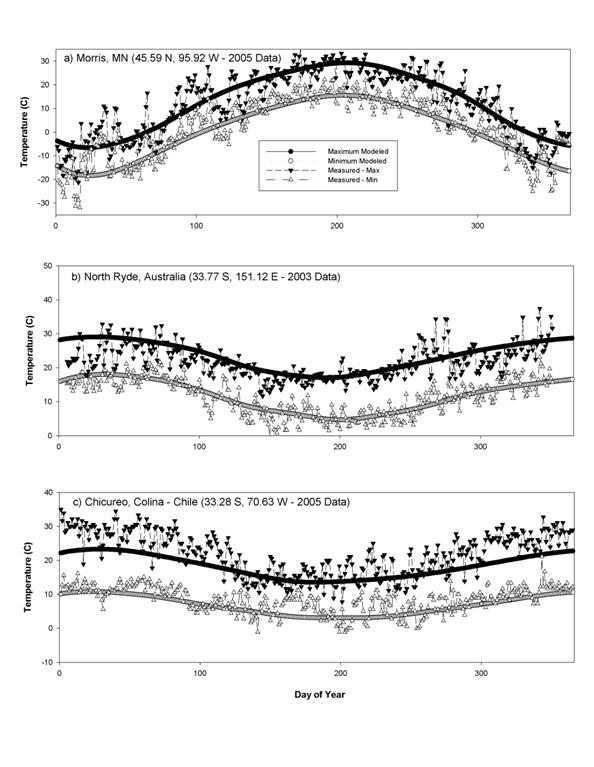| Download |

|
Welcome to the software download area! Please contact us if you have problems or questions.

Global TempSIM • Version 1.0
Java Tool to predict maximum and minimum daily air temperatures for any location on the globe
The purpose of this tool is to estimate daily maximum and minimum air temperatures for a yearly cycle at any location on the globe. Global TempSIM predicts the daily average air temperature based upon 30-yr (1961 • 1990) temperature records that were compiled and interpolated by Legates and Willmott (1990a and 1990b) with further improvements by Willmott and Matsuura (1995) (data located at http://climate.geog.udel.edu/~climate/). Diurnal temperature ranges (TDTR) were interpolated from monthly averages from data collected 1961-1990 and cross-validated by New, et al. (1999). (Data located at: http://ipcc-ddc.cru.uea.ac.uk/ddc_visualisation.html).
Both the average monthly temperatures and diurnal temperature ranges were fitted to separate spline fits to calculate estimated daily values from the spline. (See complete JAVA code for specifics).
Average daily temperature (Tmean) was used together with the daily temperature ranges to calculate daily maximum and minimum temperatures as given below:
| and |
|
User Input :
The sole input from the user is the geographical latitude and longitude as well as whether or not the daily temperatures should account for random diurnal variability. This random variability was assumed to be a function of the annual temperature amplitude at the location. This random factor produces a unique yearly temperature output that more closely mimics reality with each calculation.
Output File:
The output file is a comma spaced value (CSV) file that has the following format : DOY, Max Temp, Min Temp
This file can be loaded into a spreadsheet program (e.g. Microsoft Excel) or any other model for further analysis.
This model was developed in JAVA, is simple to use, and runs on multiple platforms (e.g. Mac, PC, Sun).
Comparisons of output from Gloab TempSIM and corresponding measured air temperature values are given in Figure 1 below.

Figure 1. Air Temperature Simulations for a) Morris, MN, b) North Ryde, Sydney Australia, and c) Chicureo, Colina Chile compared to measured data from the respective locations. Measured data was retrieved from Weather Underground (www.wunderground.com) with the years indicated in the figures.
References:
Legates, D. R. and C. J. Willmott (1990a) Mean Seasonal and Spatial Variability Global Surface Air Temperature. Theoretical and Applied Climatology , 41, 11-21.
Legates, D. R. and C. J. Willmott(1990b) Mean Seasonal and Spatial Variability in Gauge-Corrected, Global Precipitation. International Journal of Climatology, 10, 111-127.
New, M., Hulme, M. and Jones, P.D., 1999: Representing twentieth century space-time climate variability. Part 1: development of a 1961-90 mean monthly terrestrial climatology. Journal of Climate 12, 829-856.
Willmott, C. J. and K. Matsuura (1995) Smart Interpolation of Annually Averaged Air Temperature in the United States. Journal of Applied Meteorology, 34, 2577-2586.
Download Form
Please complete the form below to track the use of the service we are providing and to help improve our product.OMB 0518 - 0032 (01/2025)
According to the Paperwork Reduction Act of 1995, an agency cannot conduct or sponsor, and a person is not required to respond to, a collection of information unless it displays a valid OMB control number. The valid OMB control number for this information collection is 0518-0032. The time required to complete this information is estimated to vary from one to five minutes with an average of three minutes per response, including time for reviewing instructions, and completing and reviewing the collection of information. Send comments regarding this burden estimate or any other aspect of this collection of information, including suggestions for reducing this burden, to Department of Agriculture, Clearance Officer, OIRM, Room 404-W, Washington, DC 20250, and to the Office of Information and Regulatory Affairs, Office of Management and Budget.
